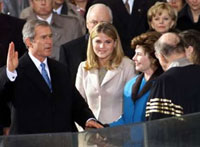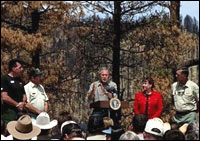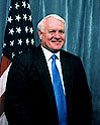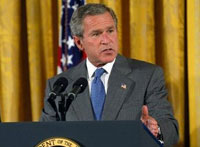Just after George W. Bush took office, two memos circulated among his top administrators that set the stage for what the president, during his campaign, promoted as a new era of environmental policy. On Bush’s first day in office, January 20, 2001, White House Chief of Staff Andrew Card sent a memo to all cabinet members directing them to ice more than 50 regulations (many of them several years in the making) that had been approved toward the end of the Clinton administration. The rules were not to be enacted unless the White House Office of Management and Budget could prove that their benefits justified their costs to the U.S. economy.

“I’ll protect the environment — I swear!”
Photo: White House.
The frozen rules included more than a dozen significant environmental ones. They called for less arsenic in drinking water, a ban on snowmobiles in national parks, controls for raw sewage overflow, stronger energy-efficiency standards, and protections against commercial logging, mining, and drilling on national lands. Of the environmental regulations that came under scrutiny, only half have since made it past the cost-benefit analysis and into the Federal Register.
In February, a second memo was sent to Bush by then-Secretary of the Treasury (and former CEO of Alcoa Steel) Paul O’Neill exhorting the president to take a strong stand on global warming. “Energy and the environment are in many ways the same problem,” wrote O’Neill. “These subjects must be considered together.” He urged Bush to become the first president to confirm publicly “the linkage between such [greenhouse] gasses and global climate change, [to] designate a targeted limit of greenhouse gas concentrations … [and to] fashion a set of world interventions.”
Not surprisingly, the memo wasn’t long for the Bush world. (Nor was its author, who resigned from the administration last December after criticism of his allegedly ineffective fiscal policies.) The memo “was as good as thrown in the trash,” said Michael Oppenheimer, a professor of geosciences and international affairs at Princeton University and formerly a longtime scientist at Environmental Defense, who was recommended in O’Neill’s memo as a Bush advisor. The following month, on March 13, 2001, President Bush reversed a campaign promise to regulate carbon dioxide emissions, saying in a private letter that doing so would be too costly. And just days thereafter, he rejected the Kyoto Protocol on global warming, a move that provoked more international contempt for the U.S. than any other action Bush took during his first year in office.
In the two-plus years since those memos were released, Bush has come under fire both domestically and internationally for environmental policies that curry favor with U.S. industrial interests at the expense of the natural world. Even Bush’s bosom buddy Tony Blair, prime minister of Britain, has challenged the president for his stance on Kyoto, equating the impact of climate change to that of weapons of mass destruction. “There will be no genuine security if the planet is ravaged,” Blair cautioned last February at an international conference on the environment.

Bush stumps for his Healthy Forests initiative.
Photo: White House.
Domestically, Democrats and moderate Republicans alike are accusing Bush of having the worst environmental record in history — of surreptitiously tearing down the regulatory framework that yielded vast improvements in the nation’s air and water quality and land conservation over the last 30 years. For example, an ongoing study by the Natural Resources Defense Council entitled “The Bush Record” chronicles hundreds of efforts to weaken environmental regulations — a tally more extensive than that of any administration (including the famously anti-environmental Reagan White House) since the U.S. EPA was established in 1971.
Even more surprising is the fact that while critics decry these changes as rollbacks, the Bush administration defends them as forward-looking: “This term ‘rollbacks’ is either a gross misrepresentation or grossly misinformed,” said James Connaughton, director of the White House Council on Environmental Quality, in an interview. “You will see significant steps forward in all areas of environmental policy under this administration.”
New Environmentalism?
Despite the Lucky-Charms language (“Clear Skies,” “Healthy Forests”) with which the Bush administration refers to its environmental initiatives, and despite the war, terrorism, and tax-cut concerns that have been distracting the press from less emotionally immediate matters, the public outrage over Bush’s environmental record is beginning to intensify as the 2004 elections draw near. Attacks on the Bush administration’s environmental record can be found in recent issues of publications ranging from Mother Jones to Vanity Fair (not exactly what you’d think of as a lefty political rag). “Every administration rewards its friends,” says the Vanity Fair expose, “but never has there been a wholesale giveaway of government agencies to the very industries they’re meant to oversee.”
So it’s no surprise that Republican strategists are getting antsy. As far back as last November, Frank Luntz warned the GOP in a memo obtained by the New York Times that the growing criticism of the administration’s environmental plan “is probably the single issue on which Republicans in general — and President Bush in particular — are most vulnerable.” Luntz outlined a detailed strategy to avoid further communication imbroglios on environmental issues, suggesting, for instance, that Republicans use the term “climate change” instead of “global warming,” because “while global warming has catastrophic connotations attached to it, climate change suggests a more controllable and less emotional challenge.”

Sunday in the park with George — and Gale, too.
Photo: White House.
The Bush administration has since made every effort to finesse its public-relations strategy, but none whatsoever to change its approach to environmental policies themselves. In fact, Bush’s environmental officials say outright that they ardently believe in staying their environmental course because it’s simply the right thing to do. Connaughton and others, including Interior Secretary Gale Norton, have publicly argued that the time has come for a paradigm shift in America’s overall environmental strategy — a shift predicated on their belief in a symbiosis between economic and environmental policies: “Strong economic growth and strong environmental performance go hand in hand,” Connaughton has said at more than a few press conferences. “You can’t have the kind of environmental improvements Americans demand without a growing economy to pay for them.”
Connaughton, Norton, and others insist that the administration isn’t just tearing down a time-honored regulatory framework; it’s setting the stage for a new system entirely — one that does not control and punish industry, but excites and motivates the market and rewards local communities that voluntarily adopt environmental protections. “The Bush administration is mobilizing a shift beyond the command-and-control regulations of the past to establish the groundwork for a New Environmentalism,” said Connaughton.
Norton echoed these themes at a recent press conference: “At the heart of the New Environmentalism,” she said, “is a recognition that … we have in many ways reached the limits of what we can do through government regulation and mandates.”
In theory, much of this “New Environmentalism” talk is compelling, particularly at a time when industry dinosaurs like Ford and General Motors are designing hybrid-engine SUVs, and Shell and BP are becoming top producers of solar panels and wind turbines. Indeed, from a business standpoint, times have changed decidedly for the better since the first command-and-control environmental regulations were enacted three decades ago. It stands to reason, then, that policies should be modernized, too.
Whigging Out
But when you sit down and connect the dots between each one of the Bush administration’s proposed regulatory changes, the final picture is not a bold vision for the future, but an aggressive and potentially calamitous scheme to return to the past — to a time before environmental protections existed at all.

Whig deal: President William Henry Harrison.
Photo: White House.
Carl Pope, executive director of the Sierra Club, sees nothing “new” about the Bush administration’s environmentalism. “It’s a very old set of ideas,” said Pope. “It goes all the way back to the Whigs, who believed the primary function of the government is to help business. These are the same ideas behind [former Vice President] Dan Quayle’s Competitiveness Council and the ‘wise use’ movement of the Reagan years.”
Other environmentalists see Bush’s agenda as grounded not so much in ideology as in political pragmatism: “It’s payback to their corporate donors, plain and simple,” said Maria Weidner, a senior researcher at Earthjustice. The Bush-Cheney campaign and the Republican National Committee received $44.1 million dollars in contributions from mining, timber, energy, chemical, and other manufacturing industries for the 2000-2002 election cycles, according to an Earthjustice report entitled “Paybacks” — more donations from those sectors than any presidential campaign in history. In January 2000, Newsweek reported that it had obtained a fundraising memo from the Bush 2000 campaign directing its big contributors to incorporate special industry tracking codes into fundraising efforts — an unprecedented system to ensure that each industry would be duly credited for its contributions.

Stephen Griles.
Photo: White House.
But the Bush administration’s love affair with industry runs deeper than tracking numbers. The president, vice president, and almost every key political appointee in administration agencies have been snatched directly from the energy, automobile, and timber industries. A few examples: Andrew Card was a chief lobbyist for the American Automobile Manufacturers Association and later for GM. Jeffrey Holmstead, director of the air division at the EPA, formerly worked as a lawyer for the utility industry, including many of the biggest polluters. Mark Rey, undersecretary for natural resources and environment at the Department of Agriculture (where he oversees the activities of the U.S. Forest Service), spent nearly 20 years working for various timber trade associations. The biggest prize for industry bias may go to Stephen Griles, number two at the Interior Department and former energy lobbyist: During two years of government service, he has continued to be paid $284,000 a year by his former lobbying firm, National Environmental Strategies, where he represented mining companies.
In the cold-comfort department, it seems that not all these industry imports are calling the shots. According to a former EPA insider who served as a high-level attorney under Christie Whitman, the EPA administrator until her resignation early this summer, many of them are just there to take orders. “The White House has never been more interventionist in rule-making. The decisions come from the offices of Dick Cheney, of Karl Rove, of John Graham at the OMB. Whitman did not take one step to counteract this avalanche from the White House to gut the rules, gut the enforcement cases, and give the coal and oil industries the day.” (John Graham, now head of the OMB’s Office of Information and Regulatory Affairs*, is the founding director of the Harvard Center for Risk Analysis, a research center heavily funded by industry.)
Freaky Fridays
Meanwhile, it seems likely that the same high-level image-makers who had Bush somersaulting onto an aircraft carrier on its way home from the Persian Gulf have also been meticulously controlling the public image of Bush’s environmental agenda. For example, the administration has developed strategic timing for its news releases, according to Robert Perks, coauthor of NRDC’s “Bush Record.” “Without fail, they announce their most controversial rollbacks just before the holidays, when most reporters are unavailable, or on Friday evenings at 5:00, after the network news has aired and everybody’s heading home. We call it the Friday Night Follies.”

Old King Coal has a friend in the White House.
Photo: USFWS.
On Friday, Nov. 15, 2002, at about 5 p.m., for instance, the administration announced a controversial decision to exempt oil and gas drilling on national lands from environmental reviews if the Interior Department deemed the likely impact “environmentally insignificant.” On the evening of Friday, Nov. 22, 2002, it announced a proposal to eliminate a key Clean Air Act program requiring power plants to adopt clean technologies when expanding their facilities. (An updated version of that proposal became official late last month.) On the evening of Wednesday, Nov. 27, 2002, as the Thanksgiving holiday began, the Bush administration announced major changes to the Forest Service’s 22-year-old environmental review procedure.
And it goes on: Just before Christmas, on Friday, Dec. 20, 2002, at 5 p.m., the EPA announced changes to the 30-year-old Clean Water Act, weakening federal supervision in favor of voluntary state-level programs. And on the evening of Dec. 23, 2002, the Bush administration announced plans to allow public lands administrators to turn hiking trails, century-old wagon tracks, and animal paths into roads for industrial activities. On New Year’s Eve, 2002, the Bush administration tried to change the requirements of the dolphin-safe tuna logo, proposing that the logo now apply to tuna caught by encircling dolphins with nets (a change that would allow Mexico and Ecuador to ship tuna to the United States). And the pattern has continued through 2003.
That the Bush administration deliberately conceals such changes from the media is not something even former White House Press Secretary Ari Fleischer denied. In a June 2002 Washington Post article, Fleischer was quoted as saying that manipulating the timing of environmental stories is a perfectly reasonable measure of self-protection: “These stories quickly become shoehorned into a ‘Bush versus the environmentalists’ formula … [ignoring] the substantive reasons why the president did it.”
“Bop Them on the Nose”
From logging to oil exploration, fuel-efficiency standards to wetlands protections, pollution controls to endangered species regulations, the breadth of regulatory changes attempted by the Bush administration in its two and a half years in office is staggering — but it’s only part of the problem. What most concerns Carol Browner, EPA administrator during the Clinton administration, about the Bush environmental strategy is not so much what’s happening to the regulations themselves but what’s happening to the underlying decision-making process. “They’re reaching in and fiddling with the A-B-C-D-E-F of the regulatory process that gets you to cleaner air and cleaner water, and that will be very hard to undo when they’re gone,” Browner said. “It could take 10 years or more to rehabilitate all those details.”
Consider, says Browner, the pollution-measurement process: A seemingly small detail such as the amount of time during which power-plant pollution levels are evaluated can have tremendous implications for environmental policy. While pollution levels were previously assessed over at least a 24-hour period, the Bush administration attempted to shorten the evaluation time to span only a handful of hours, which means the pollution can be measured during non-peak hours, when the plant is not producing much electricity.
The cost-benefit analysis is another tricky issue. What’s the dollar value of a smog-free view of the Grand Canyon, or a hike in Yosemite, or the existence of a certain species? What’s the dollar value of a human life? The OMB sparked a scientific and ethical controversy when it suggested that the life of a senior citizen — someone 70 years or older — was worth only three-fifths as much as a younger person’s life. The OMB ordered the EPA to apply the discounted value of 63 percent for elderly Americans when assessing whether to impose new restrictions on polluting industries — an apparent attempt to relieve industry of the cost of complying with pollution requirements. (This was one of the rare initiatives that drew so much public outcry that the OMB abandoned it.)
Wesley Warren, senior fellow for environmental economics at NRDC and a former OMB official during the Clinton years, says that in the Bush administration’s cost-benefit analysis for the “roadless rule,” which protected roadless national-forest lands from development, the OMB calculated that the benefits of protecting land would amount to a grand total of $219,000 — the sum the government would save every year by not having to maintain forest roads after they were built. The rule’s calculated cost, however, was roughly $180 million in potential jobs and economic activity. The analysis completely disregarded the value of recreation and cultural and aesthetic values.
Another major concern is the administration’s attempt to cut environmental enforcement. Under Bush, the number of EPA personnel assigned to conduct inspections and enforce environmental laws has fallen to the lowest levels since the agency was established. Overall, enforcement staff has decreased by more than 12 percent — from 528 to 464 — since the president took office.
The former EPA insider who served under Whitman described an alarming occasion on which she tried to address the lapse in enforcement acts with the administrator: “I told her: We’ve got a real problem. Performance is going to be down, enforcement actions are going to be down because people don’t think you’re serious about [enforcing the law]. So she goes, ‘Well I’ll say something.’ So she goes in — now remember, we have millions of regulated entities out there and hundreds of major, major corporations that we’re supposed to be regulating — so she walks into a room of senior managers at EPA and says, ‘I want you to know that I really do care about enforcement. We want people to comply voluntarily, but if they don’t, I don’t have a problem with choosing one of them and bopping them on the nose.’
“You could have heard a pin drop,” the insider continued. “I almost fell over. ‘Bop them on the nose?’ Like she does with her cocker spaniels? You can imagine. It was all I could do to contain myself before I got out of the room.”
To Market, To Market
The great irony is that the Bush administration does, on some level, have a sound basis for arguing on behalf of a new, more market-savvy era of environmental regulations. “A sea change of innovation and environmentally strategic thinking is taking place in America,” said Connaughton, echoing an optimism that has often been expressed by environmentalists. “We are in a time when companies are rapidly creating new technologies to solve environmental problems. They are outstripping government in terms of the speed by which they deal with these issues. This was not happening 30 years ago. Our policies need to tap into this trend.”
Former EPA Administrator Browner agrees: “It’s true that old-style regulatory programs are largely about doing the bare minimum: A standard is set and companies move to meet the standard and stop there. During the Clinton administrations, we were well aware that the old-style programs don’t encourage companies and communities to go further.” In fact, Browner not only realized that it was high time to introduce market- and incentive-based policies, but she also began to implement many such programs that the Bush administration is now calling its own.

Clear Skies or bold-faced lies?
Photo: White House.
So it’s not that the theories behind the Bush administration’s rollbacks and market-based strategies are in themselves completely untenable. Take, for instance, the crown jewel of the White House’s “new environmentalism” approach, its Clear Skies proposal, which seeks to cut overall power-plant emission levels by establishing a market in which utilities can buy and sell pollution credits. The so-called “cap-and-trade” approach, which builds upon a successful sulfur-dioxide emissions-trading program implemented in the 1990s, would establish a limit on how much of a certain pollutant a power plant could emit; utilities that performed better than the requirements could sell their credits to utilities that couldn’t meet the requirements.
More than a few environmentalists say that this kind of market-based strategy has tremendous potential. “What makes a cap-and-trade program revolutionary is that it creates a system in which the polluters pay the innovators,” said Fred Krupp, president of Environmental Defense, the most prominent U.S. environmental group to throw its weight behind market-based solutions. “It puts the profit motive on the side of innovating on behalf of the environment. It’s like putting traffic lights into the economy and having them turn green in the direction that we need to go — toward cleaner and ever more efficient technologies — instead of having a system that only blinks red.”
But Krupp fears that, in practice, Bush will give a bad name to this mechanism because the president has set forth inadequate goals that would ultimately do less to protect the environment than the legislation already on the books. A cap-and-trade program is only as strong as its cap. And in the long run, the Clean Skies cap would be less stringent than the current standard. Furthermore, market-based mechanisms aren’t the solution for every pollutant. Theoretically, they’d be great for non-toxic pollutants like carbon dioxide and sulfur dioxide that diffuse into the air without affecting the neighborhoods where they are emitted. But other emissions, such as mercury and volatile organic compounds, can seriously harm the air and water in the areas immediately surrounding the polluting facility. In this case, if dirty plants in Chicago bought credits from clean plants in Maryland instead of cleaning up and meeting the requirement, the Chicago community would get a bum deal.
Likewise, the idea of a voluntary cap-and-trade system, such as Bush has proposed for carbon emissions, is bogus. “We all know that history shows us that it’s a combination of carrot and stick that works in any policy, no matter what the issue,” said Sen. John McCain (R-Ariz.), who has taken the lead on proposing a mandatory carbon-trading system. “You’ve got to have incentives toward good behavior and you’ve got to have a stick toward those that refuse to behave. That’s just the way that human nature and businesses and policies work.”
We may find in the future that the Bush administration’s dogged emphasis on these kinds of incentive-based strategies — many of which were also strongly supported in the Clinton administration — was on track. But far more obvious will be the bait-and-switch tactics, the slick PR machinations, and the evidence that the Bush administration’s promising “new environmentalism” theories were executed in ways that in fact undermined the progress of environmental protection.
Editor’s note: In an effort to chronicle this pivotal moment in the history of environmental policy and help turn the tides in the direction of sensible progress, Grist Magazine is introducing “Muckraker,” a regular column dedicated to tracking day-to-day, behind-the-scenes environmental politics, inside the Beltway and beyond. The column will expose unnoticed political maneuvering (from un-enforced legislation to ruinous judicial rulings) and the activities of little-known power brokers (from EPA deputies to congressional committee chairs). It will shine a klieg light into the dark rooms where loopholes are created and exploited and ecological protections are ignored or written out of existence. Muckraker will also give credit where credit is due: When and if our political officials implement effective environmental policies or make a good argument for modernizing them, you’ll read about it here.
The mission of this column — as of the entire magazine — is to arm our readers with information about what’s happening to the environment and thereby encourage its protection. Look for Muckraker in this spot every week. (And if you’ve got a tip about environmental goings-on, don’t just sit on it; drop an email to .)
*[Correction, 03 Oct 2003: This article originally stated that John Graham was head of the Office of Management and Budget. In fact, he is head of the OMB’s Office of Information and Regulatory Affairs.]

